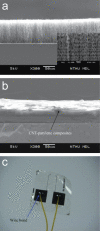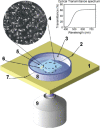Carbon-based smart nanomaterials in biomedicine and neuroengineering
- PMID: 25383297
- PMCID: PMC4222354
- DOI: 10.3762/bjnano.5.196
Carbon-based smart nanomaterials in biomedicine and neuroengineering
Erratum in
-
Correction: Carbon-based smart nanomaterials in biomedicine and neuroengineering.Beilstein J Nanotechnol. 2015 Feb 18;6:499. doi: 10.3762/bjnano.6.51. eCollection 2015. Beilstein J Nanotechnol. 2015. PMID: 25821691 Free PMC article.
Abstract
The search for advanced biomimetic materials that are capable of offering a scaffold for biological tissues during regeneration or of electrically connecting artificial devices with cellular structures to restore damaged brain functions is at the forefront of interdisciplinary research in materials science. Bioactive nanoparticles for drug delivery, substrates for nerve regeneration and active guidance, as well as supramolecular architectures mimicking the extracellular environment to reduce inflammatory responses in brain implants, are within reach thanks to the advancements in nanotechnology. In particular, carbon-based nanostructured materials, such as graphene, carbon nanotubes (CNTs) and nanodiamonds (NDs), have demonstrated to be highly promising materials for designing and fabricating nanoelectrodes and substrates for cell growth, by virtue of their peerless optical, electrical, thermal, and mechanical properties. In this review we discuss the state-of-the-art in the applications of nanomaterials in biological and biomedical fields, with a particular emphasis on neuroengineering.
Keywords: carbon nanotubes; electrophysiology; graphene; microelectrodes; nanodiamonds; nanotechnology; neuroengineering; neuronal cultures; neuroscience.
Figures






References
-
- Iijima S. Nature. 1991;354:56–58. doi: 10.1038/354056a0. - DOI
-
- Dresselhaus M S, Dresselhaus G, Avouris P. Carbon Nanotubes Synthesis, Structure, Properties, and Applications. Berlin, Germany: Springer; 2001.
-
- Wilder J W G, Venema L C, Rinzler A G, Smalley R E, Dekker C. Nature. 1998;391:59–62. doi: 10.1038/34139. - DOI
-
- Charlier J-C, Blase X, Roche S. Rev Mod Phys. 2007;79:677–732. doi: 10.1103/RevModPhys.79.677. - DOI
-
- Shtogun Y V, Woods L M. J Phys Chem C. 2009;113:4792–4796. doi: 10.1021/jp807206m. - DOI
Publication types
LinkOut - more resources
Full Text Sources
Other Literature Sources
